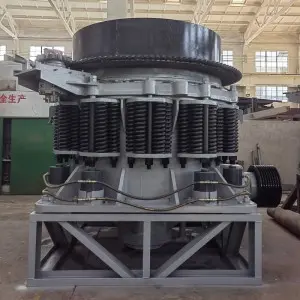In the field of material processing and crushing, various types of machinery are used to obtain the desired particle size and shape. Among them, gyratory crushers and cone crushers are the two main types of crushers, and each crusher is designed for specific applications and materials. Understanding the differences between these two types of machines is critical for industries that rely on efficient and effective streamlined processes.
Design and Mechanism
Rotary Crusher
Rotary crusher, also known as centrifugal crusher, uses a high-speed rotating mechanism to crush materials. This design typically uses a rotor that spins at high speed, creating centrifugal force that pushes the material toward a stationary surface or other material. This impact and shear force effectively reduces the size of the input material. Rotary crushers are particularly effective on brittle materials such as glass, ceramics and certain types of minerals.
Cone Crusher
Cone crushers or cone crushers work on different principles. They consist of conical structures that destroy materials through a combination of compressive and shear forces. Material is fed into the top of the cone and crushed between the outer shell and the moving inner cone. This design allows for a more controlled crushing process, making the cone crusher suitable for a wider range of materials, including hard rock and ores.
Application
Rotary Crusher
Due to their high speed operation and ability to handle brittle materials, rotary crushers are often used in industries such as recycling, where they can efficiently process waste materials into smaller, reusable forms. They are also used in the production of fine powders, for example in the food and pharmaceutical industries. The ability to achieve fine particle size quickly makes rotary crushers a popular choice for applications requiring rapid processing.
Cone Crusher
Cone crushers are widely used in the mining and aggregate industries. Their rugged design allows them to handle tough materials such as granite, basalt, and other hard rocks. Cone crushers are typically used in the secondary and tertiary crushing stages to produce more uniform particle size and shape. Their versatility makes them suitable for a variety of applications, including road construction, concrete production and mineral processing.
Efficiency and Maintenance
Rotary Crusher
One of the advantages of rotary crushers is their high throughput. The centrifugal force generated by the rotor can quickly process materials, thereby improving production efficiency. However, high-speed operation also results in increased component wear, requiring regular maintenance and replacement of components to ensure optimal performance.
Cone Crusher
Cone crushers are known for their durability and reliability. Their design allows for a more progressive wear pattern, extending the life of the machine. While they may not achieve the same high throughput as cord breakers, their efficiency in producing consistent product sizes can make them more cost-effective in the long run. Regular maintenance is still necessary, but maintenance intervals may be longer compared to spin breakers.
In summary
In summary, gyratory crushers and cone crushers differ in their design, mechanism, application and maintenance requirements. Rotary crushers excel at processing brittle materials at high speeds, making them ideal for recycling and fines production. In contrast, cone crushers are better suited for processing hard materials in the mining and aggregates industries, providing durability and consistent crushing results. Understanding these differences can help industries select equipment that suits their specific needs, ultimately improving operational efficiency and productivity.
Post time: Oct-16-2024

